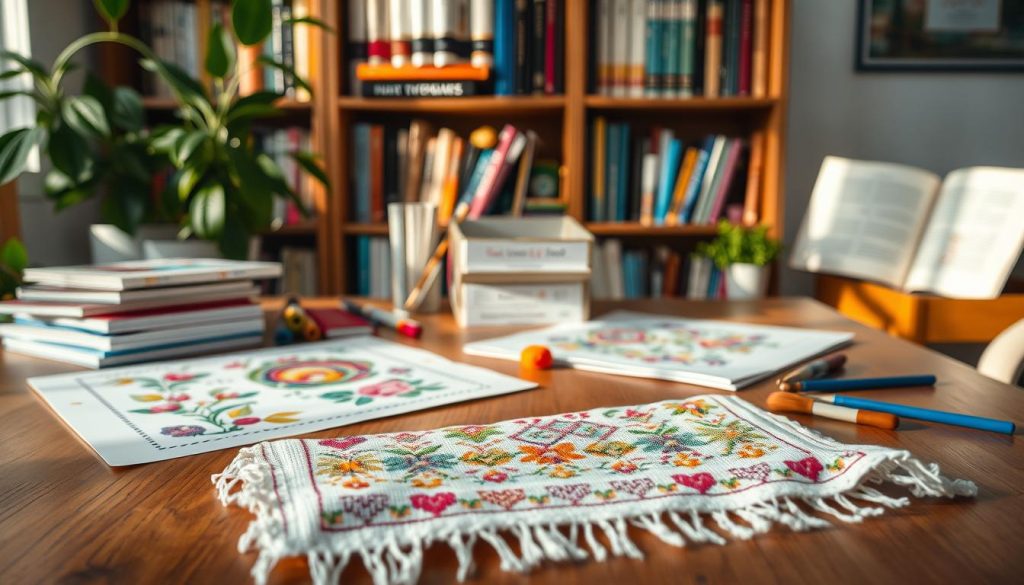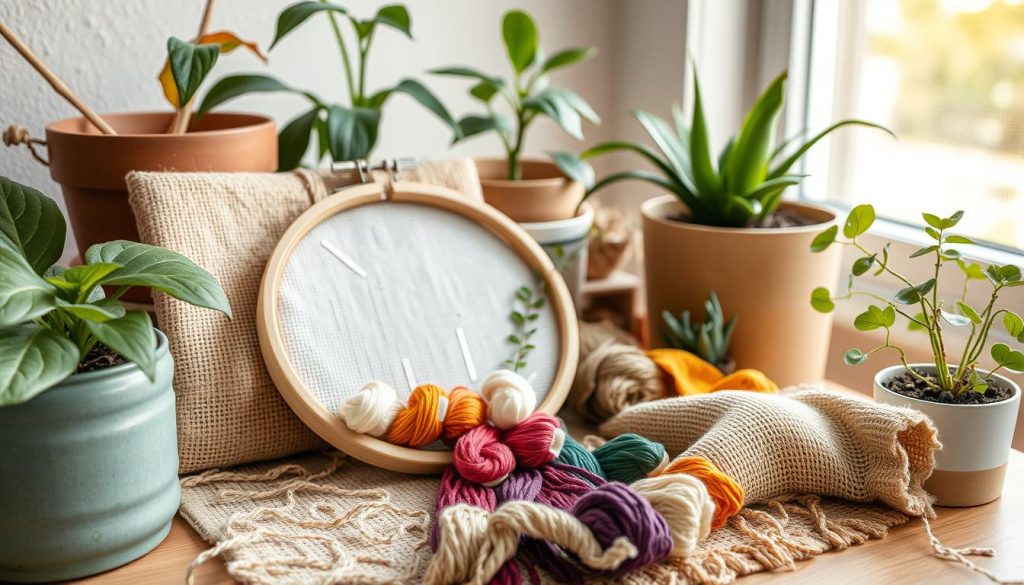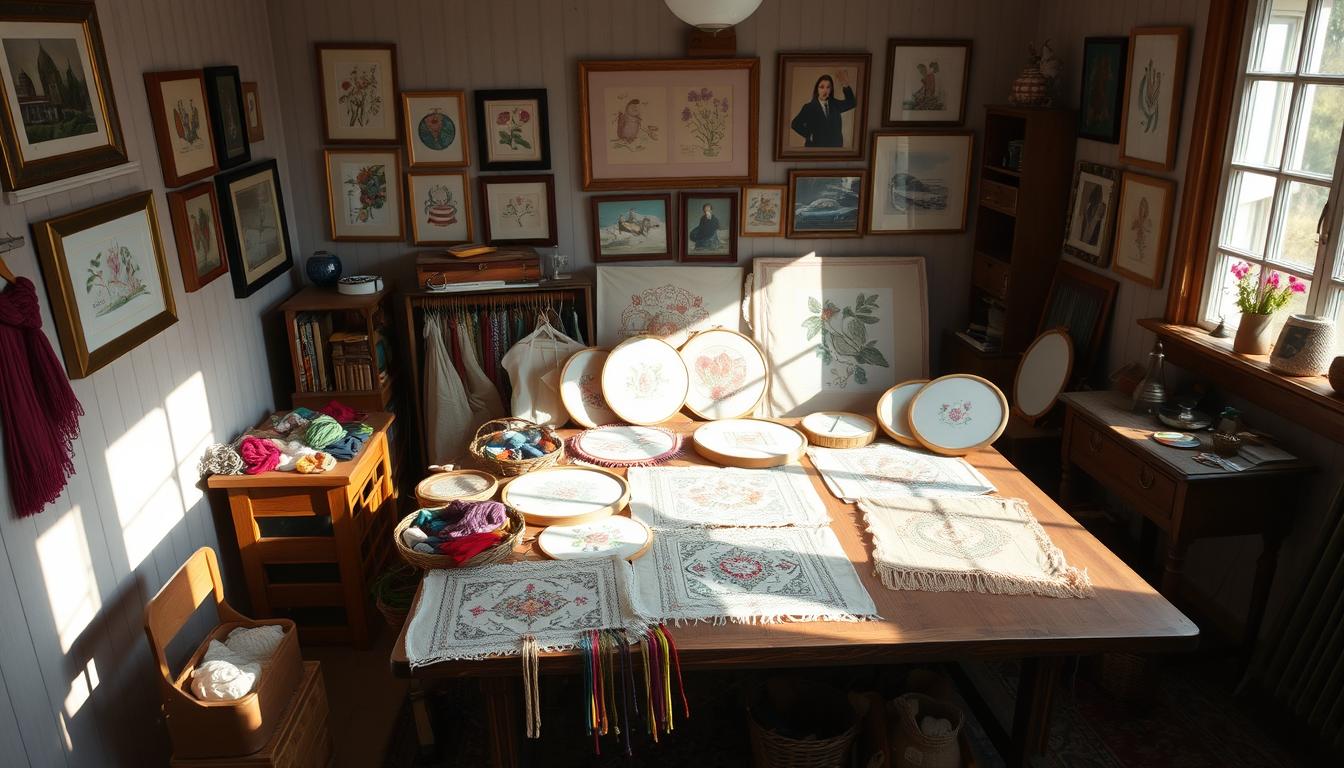Cross stitching is more than a hobby or art form. It brings back memories of your grandmother’s pillows and wall hangings. This craft has deep roots, dating back to ancient Egypt and revived in the 19th-century Arts and Crafts Movement. It beautifully combines tradition with modern design.
It offers mental wellness, personal creativity, and social connections. These are just a few of the many unseen benefits of cross stitching.
The materials used in cross stitching include Aida cloth and specialized software like PCStitch. These tools help create custom patterns. You can make everything from Christmas stockings to baby quilts, which can be passed down through generations.
Let’s explore these hidden benefits to see why cross stitch is becoming popular again today.
Key Takeaways
- Cross stitching offers mental health benefits by promoting mindfulness and satisfaction.
- It allows for significant personal creativity and expression, from crafting Star Wars-themed patterns to baby quilts.
- Social connectivity is enhanced through online communities and digital platforms like Pattern Keeper.
- Educational benefits arise from the attention to detail and discipline required to count and stitch patterns.
- Sustainability is a focus in cross stitching, with many opting for eco-friendly materials.
Stay tuned for more insights into how cross stitch can transform various aspects of your life.
Mental Health Benefits of Cross Stitching
Cross stitching is more than just a hobby. It’s a powerful way to reduce stress and anxiety. It brings a calming rhythm, similar to meditation, to people of all ages. Craft lovers often say it helps them get into a ‘flow’ state, where they feel fully engaged and clear-minded.
For teens, cross stitching can channel their energy into something positive. It’s a great way to reduce stress and anxiety. The repetitive motion helps them express their creativity in a healthy way. New moms also find it fulfilling, giving them a break from the constant care of a baby and helping with postpartum blues.
Studies from Johns Hopkins Medicine show that cross-stitching can lower negative thoughts and depression symptoms. The Alzheimer’s Association also notes that it can slow down brain aging and prevent dementia. A 2013 study found that 81% of participants felt calm and happy after doing similar crafts.
Working on cross-stitch projects together can bring kids closer and start meaningful talks in a tech-filled world. Adults can also meet new people by joining online groups or local crafting clubs. This social connection is linked to better mental health, lower depression, and longer life, as the American Journal of Public Health found.
The mental health perks of cross stitching are wide-ranging. It improves focus, reduces stress, and boosts overall well-being. Through cross-stitching, people can feel a sense of control and calm, vital in today’s fast-paced life.
Creativity and Personal Expression in Cross Stitching
Cross stitching is a great way to express yourself and be creative. You can make unique cross stitch designs that match your style and home. It’s all about personal taste and creativity.
Today’s cross stitch kits offer many patterns to choose from. You can make simple or complex designs. Some kits even let you customize your project, making it truly yours.
Tools like PCStitch and Pattern Maker have changed how we make cross stitch patterns. They help turn photos or designs into detailed, printable grids. This makes making your own cross stitch easier and more precise.
The type of material you use is important too. Aida cloth helps beginners follow patterns easily. Using high-quality fabrics and lots of floss colors makes your projects special and unique.
Crafters use different stitches to add texture and depth. Techniques like full cross stitch and back stitch are common. Traditional stitches like satin stitch and French knots add more complexity and beauty.
With cross stitch, you can make anything from small gifts to big artworks. It takes time, but every piece shows your creativity and individuality. Cross stitch is a mix of craft and personal expression.
Whether you’re making something for your home, a gift, or just for fun, cross stitch is rewarding. It suits all skill levels, from beginners to experts. It’s a calming and creative activity that brings joy.
Social Connectivity Through Cross Stitching Communities
Joining online groups and forums can really boost your cross-stitching fun. You can share your work, get tips, and celebrate with others worldwide. For example, the Tatreez community connects people from Canada, the US, the UK, Australia, South Africa, Mexico, and Colombia.
Local workshops and events are great for meeting others. The Puerto Rican Embroidery Squadron has over 60 women, showing unity and strength. Each Stitching Social event, with up to 12 people, costs £42.90 for two hours. You get a beginner kit and more.
More than a hobby, cross-stitching builds emotional support and skills. The Threads of Diaspora project got more support than expected, showing community strength. Online, you can find many cross-stitch patterns in different sizes and styles.
DIY kits like the Cross Stitch Bookmark 18CT let you choose colors, adding to the fun of making something by hand. Cross-stitching is not just calming but also a way to find yourself through art.
By joining online groups or attending events, you meet others who love cross-stitching. Sally, Carla, Charlie, Annie, and Mandi are hosting events in June and July 2023. With Zoom links and support, you can easily join these lively communities and improve your stitching.
The Educational Value of Cross Stitching
Cross stitching is more than a hobby; it’s a way to learn patience and discipline. Kids as young as 5 can start with simple patterns. These activities improve their hand-eye coordination and dexterity.
A beginner’s cross-stitch kit includes fabric, a needle, thread, and a hoop. Working on these projects helps kids focus for longer. With each stitch, they learn patience and discipline, skills that last a lifetime.

A clean and well-lit workspace is key for cross-stitching. Setting small goals keeps kids motivated. As they craft, they improve their fine motor skills and patience.
The history of cross stitch adds to its educational value. For example, Loara Standish’s 1653 sampler teaches us about heritage. Cross stitch samplers were once used to teach young women to sew. Erica Wilson’s book “Crewel Point” in 1962 made it even more popular.
| Brand | Year Established | Number of Colors |
|---|---|---|
| DMC | 1746 | Over 500 |
| Zweigart | 1890 | N/A |
Engaging in cross-stitching is a great way to learn patience and discipline. It also helps develop cognitive and creative skills. This craft is not just fun; it’s a powerful tool for lifelong learning and growth.
The Versatility of Cross Stitch in Modern Design
Modern cross stitch has become a big part of home decor and embroidery today. This old craft has changed to fit modern tastes, making it key in stylish homes.
Cross stitch is no longer just for fabric. Now, it’s in frames, on walls, in pillows, bags, and clothes. This lets people pick materials that match their style and home.
Contemporary embroidery mixes needlework with art, letting people show their creativity. Beginners start simple but soon find complex designs to make spaces special.
Looking at 36 covers from top UK cross stitch magazines shows 13 design themes. This shows what themes are popular in the cross stitch world.
| Theme | Prevalence |
|---|---|
| Cute Animals | 14 |
| Anthropomorphism | 10 |
| Floral | 8 |
| Christmas | 6 |
| Landscapes | 5 |
| Fantasy | 4 |
| Love | 3 |
| Slogans | 3 |
| Sampler | 2 |
| Nature | 1 |
| Pattern | 1 |
| Portraits | 1 |
| Transport | 1 |
This data shows the wide range of modern cross stitch themes. It’s perfect for adding a personal touch to any room. Whether you like flowers or fun figures, cross stitch can make your space unique.
Cross stitch has also moved online, reaching more people. Online groups offer support and ideas, helping both new and experienced stitchers. This mix of old and new keeps cross stitch exciting and meaningful in today’s homes.
Cross Stitch and Sustainability
The world is waking up to environmental issues. Using eco-friendly materials in cross stitching is a big step towards being green. Earth Day, celebrated since 1970, reminds us to choose sustainable crafts in our hobbies, like cross stitching.

The Green Dot and Triman Symbol are key in eco-friendly cross stitching. Some DMC skeins show these symbols. The Green Dot means the producer helps with recycling in Europe. The Triman Symbol shows the packaging can be recycled.
Choosing wooden hoops over plastic is another green choice. Wooden hoops are biodegradable and compostable. This change can cut down on waste in cross-stitching.
Using digital patterns instead of printed charts also helps. It reduces paper waste, supporting eco-friendly cross stitching.
Donating extra cross-stitching materials and reusing old fabrics is also good. Old fabrics can be dyed or used for smaller projects. This approach helps avoid waste in crafting.
ORTs (Old Raggedy Threads) and non-biodegradable aida canvas are bad for the environment. Washing canvas to remove starch makes it better for disposal. Choosing recyclable canvas is another way to improve cross stitch sustainability.
| Material | Eco-Friendly Alternatives | Benefits |
|---|---|---|
| Plastic Hoops | Wooden Hoops | Biodegradable and Compostable |
| Printed Charts | Digital Patterns | Minimizes Paper Waste |
| Excess Threads | Donate or Reuse | Promotes Zero-Waste |
| Non-Biodegradable Canvas | Recyclable Canvas | Reduces Environmental Impact |
When you start cross stitching, think about using greener practices. Your choices can make a big difference. They help create a sustainable future for everyone.
Conclusion
Cross stitching offers many benefits, as we’ve seen in this article. It helps with mental health, boosts creativity, and lets people express themselves. Many find it calming, thanks to its rhythmic and meditative nature.
Being part of cross stitch communities, online or local, brings people together. It’s a chance to share and learn from others. This craft also improves fine motor skills, teaches patience, and shows the value of precision.
Today, cross stitch blends tradition with modern design, creating unique pieces. Many stitchers use materials wisely, often having leftover thread. This shows the craft’s resourcefulness and commitment to sustainability.
In summary, cross stitching is rewarding for many reasons. It offers therapy, creativity, and a way to connect with others. Whether you’re new or experienced, there’s a place for you. Following instructions well helps avoid mistakes and makes your projects more enjoyable.
